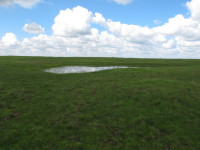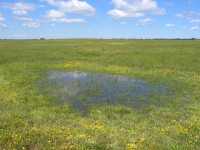

Area: 1,427 acres
Location: Sacramento County, CA
Date Acquired: 1996
Acquisition Type: CNLM holds a conservation easement to protect imperiled species and habitats that exist on the preserve in perpetuity.
Key Habitats: California Annual and Perennial Grassland, Vernal Pool
Species of Special Interest to CNLM: Vernal pool tadpole shrimp (Lepidurus packardi), Vernal pool fairy shrimp (Branchinecta lynchi), Boggs Lake hedge-hyssop (Gratiola heterosepala), Western spadefoot toad (Spea hammondii), Swainson’s hawk (Buteo swainsoni) and California tiger salamander (Ambystoma californiense ).
Introduction
The preserve was established in 1996 by the AKT Development as mitigation for vernal pool impacts from vineyard development. The conservation area was established for the benefit of vernal pool habitat and its associated species.
Conservation Significance
The Preserve lies within a large area of high terrace grasslands derived from the Laguna Formation within the Mokelumne River watershed. The landscape of the Preserve is characterized by rolling hills and mound-inter-mound topography. The land surrounding the Preserve is primarily vineyards and rangeland. Prior to the Preserve’s establishment, the land comprising the Preserve had been part of a cattle ranch for more than 100 years.
The Preserve is dominated by non-native annual grassland (1,338 acres). More than 1,480 vernal pools (51 acres) are scattered throughout the uplands, and are classified as northern hardpan vernal pools. In addition to vernal pools, the Preserve’s wetlands include stock ponds (1.4 acres), intermittent drainages (0.5 acres), and seasonal wetlands (15.3 acres).
The Preserve provides habitat for the state threatened Swainson’s hawk (Buteo swansonii), the federally-endangered vernal pool tadpole shrimp (Lepidurus packardii), the federally-threatened vernal pool fairy shrimp (Branchinecta lynchi), the state- and federally-threatened California tiger salamander (Ambystoma californiense), the state endangered Boggs lake hedge-hyssop (Gratiola heterosepala), and species of concern include western spadefoot toad (Spea hammondii) and burrowing owl (Athene cunicularia).
Our Work
The landowner is responsible for management of the Preserve. Cattle grazing is the primary management tool used to provide short grass habitat, control invasive non-native plants, and enhance vernal pool flora and fauna. The species composition of plant and animal life at the Preserve is dependent on vegetation management. The Preserve has been grazed over the last century and has maintained these sensitive species and habitats, replacing what was historically managed by wildfire and wildlife grazing.
CNLM holds a conservation easement over the Preserve and is responsible for monitoring, enforcement, and defense of the Preserve to ensure that the sensitive habitats and species are protected in perpetuity.
Public Access
Due to the vulnerability of the species and habitats that exist on this preserve, it is not open to the public.
Contact
For information about Borden Ranch Preserve or Center for Natural Lands Management please contact Cathy Little, Regional Preserve Manager at CLittle@cnlm.org or 760.731.7790 extension 209.



